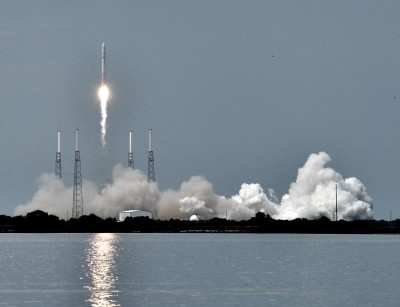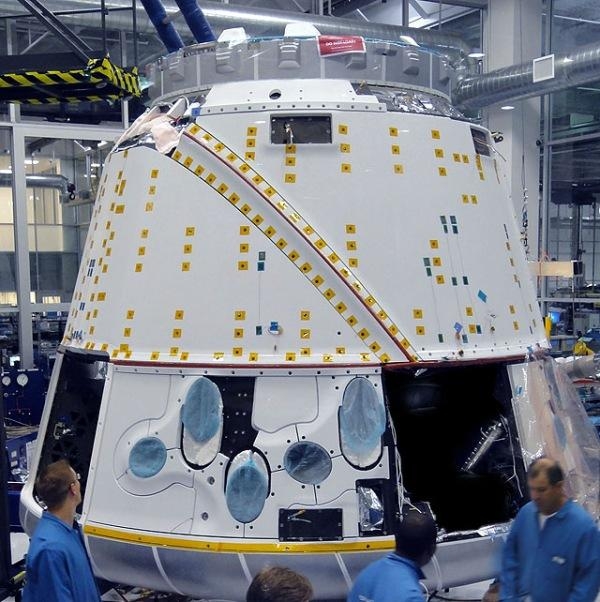A Lot Of Eggs Are In The SpaceX Basket
Commentary and Analysis By Wes Oleszewski
At this moment, there are two nations on earth capable of
putting humans into space - and we, here in the United States,
ain’t one of them. Although that simple statement may sound
shocking, its truth alone should shake us all to the core. And if
it’s a bit hard to choke down- get used to it. The nation
that once had astronauts driving on the moon and later developed a
fleet of space planes that could be flown over and over, today
cannot place a human into earth orbit and that is not likely to
change anytime soon.
Falcon 9 Launch

Our current void in the “capability” to place our
astronauts into space aboard our hardware is something the United
States has not seen in a half century. When the final Apollo
spacecraft flew on the Apollo Soyuz Test Project (ASTP) in 1975,
the nation knew that our space program had a future and an upcoming
capability with the Space Shuttle. In fact, just two years and
three weeks after the end of the ASTP, two US astronauts landed the
orbiter Enterprise at Edwards in the first Approach and Landing
Test. Granted, the Enterprise was little more than an orbiter
mock-up garnished with active flight controls and computer systems,
yet it was symbolic of the fact that we had a follow-on space
program with actual hardware and that we were advancing in a very
specific direction. So although we did not have the
“ability” to put people into space for just over five
years, we maintained and developed the capability. During the
shuttle program stand-downs following both the Challenger and
Columbia accidents, no US astronauts flew in space, but we still
had the capability in hardware, facilities and manpower. Following
the retirement of the shuttle in July of 2011, the capability of
the United States to place humans into space was retired wholesale-
and no firm direction toward the return of that capability was
offered by our national “leadership.” Although NASA
grudgingly announced the upcoming Space Launch System (SLS),
political support from the Obama administration was nearly
invisible and flight schedules were based more on expected funding
than on clear goals. Nearly a half year after the official SLS
announcement a NASA committee is still working on missions and a
schedules with the first unscrewed flight (singular) in about 2017
and the first crewed flight (singular) in about 2021. Thereafter an
gaunt two-flights-per-year SLS schedule is being considered. As far
as NASA is concerned, the near future does not look bright for US
human spaceflight.
With NASA management apparently in a three way space-race with
an accountant and a garden slug, it appears as if the “GO
oriented” attitude that was once symbolic of America’s
human spaceflight program has either been retired with the shuttle
or canceled with NASA’s last dozen well illustrated computer
graphic spaceflight projects. Yet, out of the wreckage of
Bush’s underfunded “Vision for Space Exploration”
and Obama’s directionless “NewSpace” is emerging
an effort that actually has that “GO oriented” attitude
in human spaceflight- it is the Commercial Crew Development program
(CCDev).
Heritage spaceflight companies such as Lockheed Martin, ATK and
Boeing along with new comers to human spaceflight such as Sierra
Nevada, Orbital and SpaceX, et al. are the major players in
the commercial manned spaceflight effort. At this moment the
greatest chance for getting Americans back into space from United
States soil aboard a US built vehicle appears to be in the lap of
Space Exploration Technologies Corporation, AKA- SpaceX. For the
highly motivated, highly skilled technology innovators at SpaceX,
this moment in history must seem like their wildest dreams have
come true. Yet, we on the outside can only imagine that they are
feeling a good deal of pressure as well.
SpaceX Dragon COTS Spacecraft

On the 18th day of March, 2010 a Senate hearing was held, the
subject was; “Assessing Commercial Space Capabilities.”
The witnesses invited to testify at the hearing were Lieutenant
General Thomas P. Stafford (USAF, NASA Astronaut, Gemini 6, Gemini
9, Apollo 10, ASTP), Mr. Bryan D. O'Connor (NASA- Chief,
Safety and Mission Assurance), Dr. George C. Nield (Associate
Administrator for Commercial Space Transportation, FAA), Mr.
Malcolm L. Peterson (Former NASA Comptroller), Mr. Michael C. Gas
(President and Chief Executive Officer, United Launch Alliance),
Mr. Frank L. Culbertson Jr. (Senior Vice President and Deputy
General Manager, Advanced Programs Group, Orbital Sciences
Corporation) and Ms. Gwynne Shotwell (President, SpaceX). Some 125
minutes into the hearing Senator Nelson put forward some
questioning as to the cost and how soon any of the
“commercial” launch services could place a crewed
spacecraft up to the International Space Station (ISS). While the
other launch providers had given an earlier estimate of four to
five years after they were contracted by NASA, Ms. Shotwell
confidently said that SpaceX could “…guarantee flights
to the ISS for less than $50 Million…” To which
Senator Nelson quickly asked, “How soon?” and Ms.
Shotwell replied “Three years from the time we
initiate.” At that moment, the other witnesses appeared a bit
stunned at the statement. THREE YEARS?! from a company that had yet
to even fly the Falcon 9 booster that was supposed to do the job?
Indeed, many of us in the spaceflight media, including myself, at
that time saw that statement as being both arrogant and
over-confident. Yet, after pondering at greater length Ms.
Shotwell’s attitude, it may be better considered to be
neither arrogant nor over-confident, but “GO
oriented.”
Artist's Concept SpaceX Dragon On
Orbit

While the Space Shuttle orbiters are being rapidly degraded into
museum pieces, a huge portion of the US human spaceflight workforce
is standing in the unemployment line, human spaceflight
infrastructure is being hauled away for scrap and NASA astronauts
are forced to hitch rides aboard Russian Soyuz vehicles at a price
of $54 million per seat or more- there are a lot of eggs in the
SpaceX basket. Now, 22 months after Ms. Shotwell placed that
statement into the congressional record- a GO oriented attitude may
be just what we need.
With the successful launching of their Falcon 9 in mid 2010 and
their successful orbital flight of a Dragon spacecraft in December
of that same year, SpaceX appeared to have hit the ground running.
Yet a series of delays caused the year 2011 to pass without a
single SpaceX flight. As if to make up ground in early 2012, they
have poised themselves to up the stakes significantly by combining
the COTS-2 Demo. mission with the COTS-3 demo mission.
“COTS” is NASA’s Commercial Orbital
Transportation System whereby “private” or
“commercial” spaceflight operators will send their own
boosters and spacecraft up to supply the International Space
Station (ISS). SpaceX’s COTS-1 mission was a successful
orbital flight of the Dragon capsule and a subsequent recovery.
COTS-2 was billed as an ISS flyby flight with a Dragon spacecraft
approaching the ISS but staying six to seven miles away from
it. The COTS-3 demo would actually have a Dragon spacecraft dock
with the ISS. In the recently approved combined mission profile the
Dragon will rendezvous with the ISS about nine days after SpaceX
launches the vehicle and then will be captured by the
station’s remote manipulator arm and be positioned at a
docking port. That mission is now scheduled for February 7,
2012.
If, as a cynic, you consider each of the upcoming SpaceX flights
to be nothing more than motions in an already delayed effort to
fulfill the COTS agreement, you would be correct. However, in doing
so you will be missing the larger picture. As a nation, we MUST
resume our role as the leader in human spaceflight and we need to
do so RIGHT NOW. Thus, although the COTS flight are only of a cargo
nature, each of these up-coming flights are also a critical step in
the direction back toward United States leadership in human
spaceflight as well. The basic Dragon spacecraft has been designed
to haul either cargo or crew. Thus each time a Falcon 9 and a
Dragon spacecraft flies they are fulfilling COTS requirements and
at the same time laying the foundation for manned Dragon operations
in CCDev.
CCDev Concepts

Of course, SpaceX is far from being the only game in town. Other
“commercial” providers- Lockheed Martin, ATK, Boeing,
Sierra Nevada and Orbital are making great strides in the area of
commercial crew spaceflight. Assuredly, each has a “Go
oriented” spirit within their company as they work toward
their goals. And each has their own external fan club and each has
their own detractors- as does SpaceX. This point in history,
however, is not the time for “my-team vs. your-team”
trash-talk. What will be happening with SpaceX and the other CCDev
prospects in the next few years is not a sporting event. Instead
the upcoming events represent a critical series of steps in the
attempt to get this nation’s future in spaceflight technology
back on track.
Set aside the political myopia and deliberate de-developmental
efforts that have put America’s human spaceflight program
into the mess where it resides right now. Anyone who honestly
desires to see US human spaceflight again moving forward from US
soil should be looking toward in the next SpaceX launch with a GO
oriented attitude. The same goes for the steps being taken by other
commercial operators. GO! should be the word most commonly spoken.
Negativity will get us nowhere as a space-going nation. The
only attitude that will lead anywhere is one that is highly GO
oriented. SpaceX clearly has it and the rest of us would do well to
catch it.
 ANN's Daily Aero-Linx (04.15.24)
ANN's Daily Aero-Linx (04.15.24) Classic Aero-TV: 'No Other Options' -- The Israeli Air Force's Danny Shapira
Classic Aero-TV: 'No Other Options' -- The Israeli Air Force's Danny Shapira Aero-News: Quote of the Day (04.15.24)
Aero-News: Quote of the Day (04.15.24) Airborne 04.16.24: RV Update, Affordable Flying Expo, Diamond Lil
Airborne 04.16.24: RV Update, Affordable Flying Expo, Diamond Lil ANN's Daily Aero-Term (04.16.24): Chart Supplement US
ANN's Daily Aero-Term (04.16.24): Chart Supplement US






